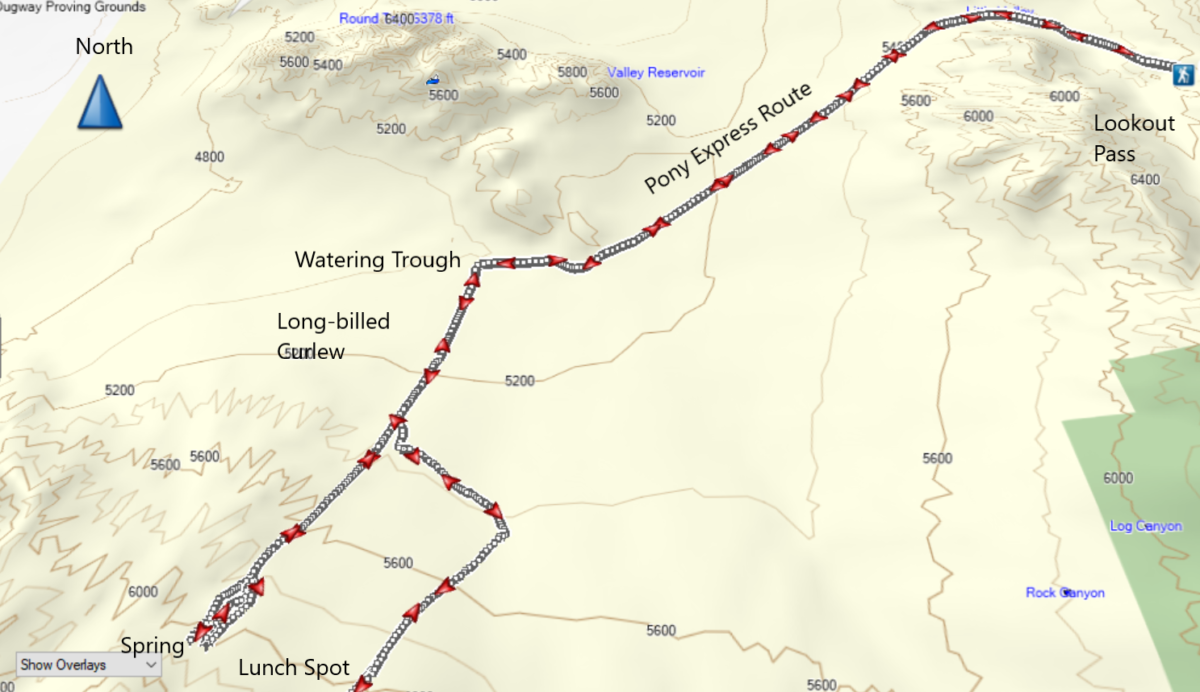ATV Adventures: In search of wild horses on the Pony Express Trail

Lynn R. Blamires
Approaching the spring on the west side of Indian Peaks.Trying to recreate a wild horse experience we had in June of last year on the Pony Express Trail, we unloaded our machines at Lookout Pass.
The Pony Express Riders made their way west near Lehi, then to Camp Floyd. At Faust the trail makes a jog left on Highway 36 and up to Lookout Pass. Signs on the highway make the route easy to find.
From the pass, we made our way toward the Simpson Springs Pony Express Station through Little Valley looking for wild horses. This area is home to the Onaqui Mountains wild horse herd.
What we learned is that wild horses are where you find them and on this day we did not find them. Apparently they did not get the memo to be at this spot on this day to be admired.

Lynn R. Blamires
A map of the route we took.
Disappointed, we continued our ride toward Simpson Springs and noticed the large watering trough that had been set up for the horses. Being just off the road, we stopped to get a closer look at it.
The trough is narrow and long to allow more horses to drink at the same time. It is fed by a constantly flowing well that ensures clear water for the animals. Seeing a trail that headed south into the Simpson Springs Hills, we took it.
As we began to climb, we left the dry valley and encountered the evergreen junipers in the hills. The higher we climbed the more numerous they were.
At 6,000 feet we came upon a spring. It was not marked on any map that we had, but it covered a large area. The grass was lush and green here. It must have been deep in parts because while we were there, we were serenaded by a chorus of frogs. This was 1,000 feet above the watering trough we had left in the valley below. We were on the north side of this mountain, 1,400 feet below the highest point, Indian Peaks to the south.
While this spring may not be well known among humans, I am willing to bet that animals know all about it. It would be fun to set up a trail camera on this site to see the variety of wildlife that would come to it.
Because of the spring and not wanting to disturb it, we turned around and made our way back down the trail to a junction we had passed earlier. We turned east, which brought us to a junction with another trail that turned back up the mountain.
This one also came to a dead end, but that was not disappointing because it was a nice place to stop for lunch. We ate among the trees and talked about the beauty of the backcountry. From our elevated vantage point, there were some beautiful views of the mountains around us.
Looking at a map of this area, I found it laced with trails. Some of them were dead ends, but others seemed to go for miles. We were in the bounds of the Prospector Trail System, whose trails measure in the hundreds of miles. While it is best ridden in the spring or fall, it is a trail system that I would like to spend more time exploring.
Tummies taken care of, we decided to head back to the trucks. Reconnecting with the trail we had taken up from the watering trough, we were making our way down, when we spotted a large bird to the west.

Lynn R. Blamires
From our vantage point at our lunch stop we had a pretty view
It had a long, curved beak and it looked like a bird that would be found near water. It wasn’t bothered to see us and when we tried to get a closer look, it moved, but it didn’t go far and it would always come back. I took a picture and later when I was in front of my computer, I tried to identify it. As near as I could tell it was a long-billed curlew. Being a shorebird, it seemed to be out of place until I thought of the spring we had discovered earlier. This would have been one of those visitors to the spring that would be picked up on a trail camera.
Continuing our trek to the trucks, our hopes that the wild horses had received the memo evaporated. It was not a long ride, only about 33 miles, but it was worth the trip. When you go, take plenty of water, keep the rubber side down, and good luck finding the wild horses.
Contact Lynn Blamires at quadmanone@gmail.com.
